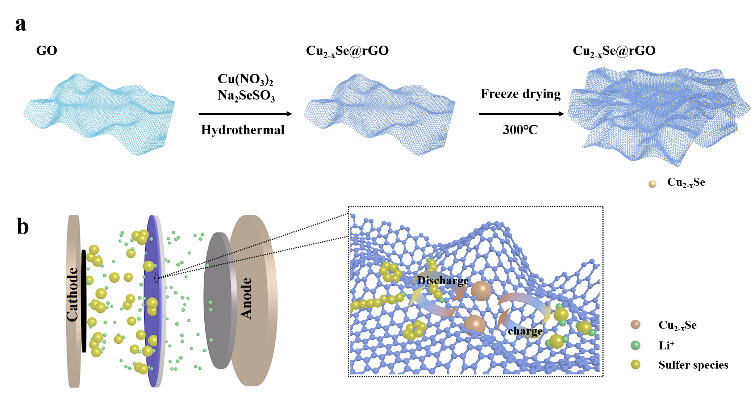M. Yuan, H.D. Shi, C. Dong, S.H. Zheng, K. Wang, S.X. Wang*, Z.-S. Wu*
2D Materials, 2022, 9, 025028.
DOI: 10.1088/2053-1583/ac5ec6 [PDF]

To conquer the vital challenges of lithium-sulfur (Li-S) batteries in practical application including low capacity and poor cycle stability caused by polysulfide shuttling behavior, the physical/chemical entrapment is regarded as an effective method to inhibit and catalyze polysulfides. Herein we design a cross-linked framework of reduced graphene oxide anchored with Cu2-xSe nanoparticles (Cu2-xSe@rGO) by building an electrolyte/Cu2-xSe/graphene triple-phase interface to be a high-efficiency electrocatalyst for Li-S batteries.Imporatnly, this 3D conductive network possesses a large specific surface area with high ion transport capability, meanwhile providing strong physical constraint for efficient adsorption of soluble polysulfides. Further, this triple-phase catalytic interface provides strong chemical adsorption and abundant Cu2-xSe nanoparticle sulfiphilic active sites, effectively inhibiting the dissolution of polysulfides and guaranteeing the efficient polysulfide adsorption catalysis as well as rapidly uniform Li2S nucleation. Consequently, with the Cu2-xSe@rGO separator, a low capacity decay rate of 0.059% per cycle at 2 C after 500 cycles is obtained. What’s more, over 100 cycles, a high capacityof805 mAh g-1can still be maintianed at a high areal sulfur loading of 3.0 mg cm-2. Therefore, this work will open new avenue to construct 2Dtransition metal selenide for superior performance Li-S batteries.